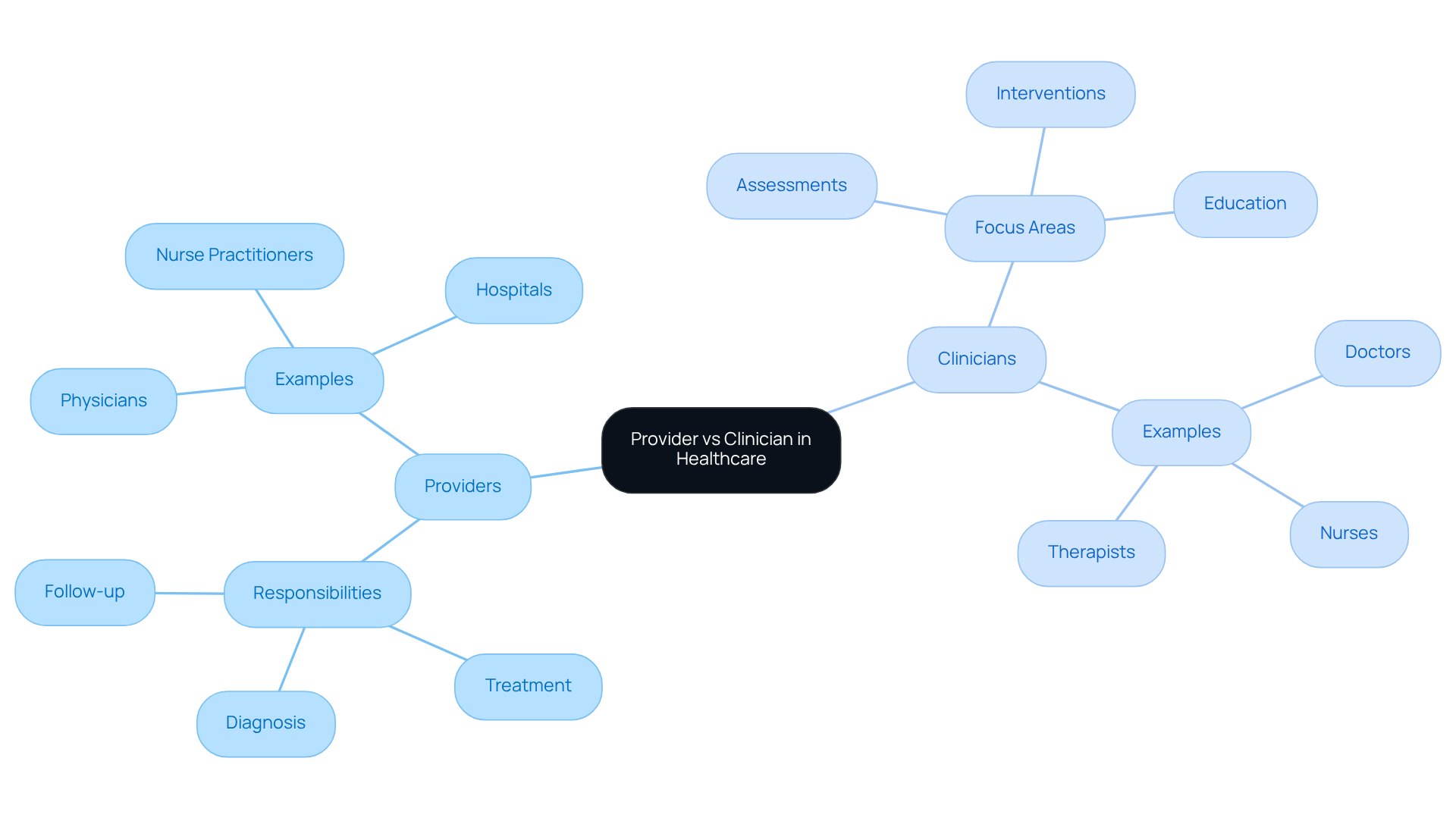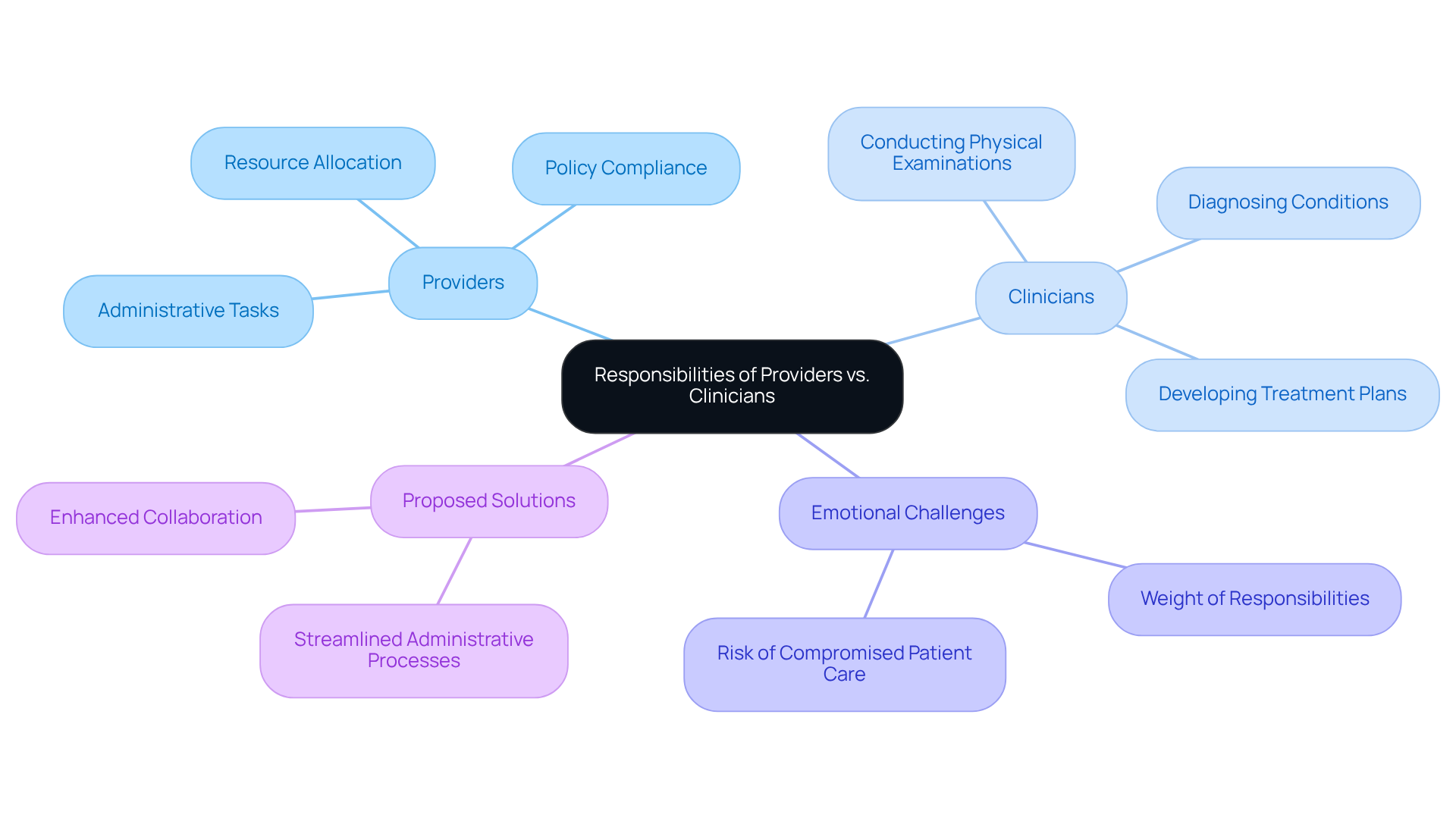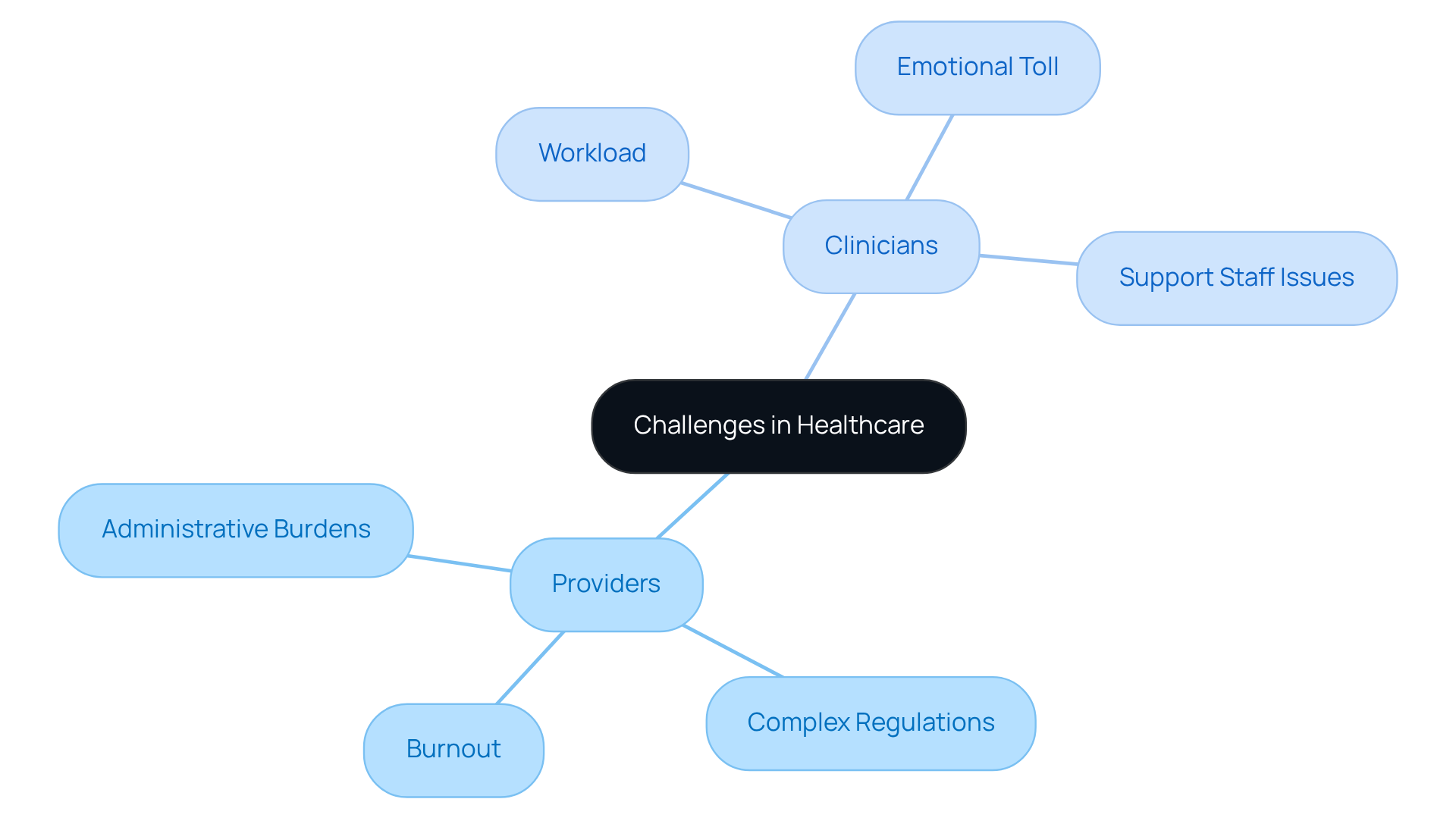Overview
This article compassionately explores the key differences and challenges faced by healthcare providers and clinicians. Providers oversee the overall management of medical services, while clinicians dedicate themselves to direct patient care. Have you ever considered the emotional burdens that both roles carry? This distinction is crucial, as it highlights the administrative challenges that can weigh heavily on professionals, ultimately impacting patient care.
The emotional toll of these responsibilities is significant. Administrative tasks often distract from the core mission of providing quality care, leading to frustration and burnout. This situation not only affects the professionals involved but also has a ripple effect on the patients they serve. By recognizing these challenges, we can begin to address them effectively.
Supportive measures are essential to improve both patient care and professional satisfaction. What can we do to alleviate these burdens? Implementing streamlined processes and providing emotional support can make a world of difference. Together, we can foster an environment where both providers and clinicians feel valued and empowered.
Let’s engage in a conversation about how we can support each other in this vital work. Your experiences and insights are invaluable as we strive to enhance the healthcare landscape for everyone involved.
Introduction
In the intricate ecosystem of healthcare, the terms "provider" and "clinician" often evoke confusion. Yet, they represent distinct roles, each with unique responsibilities. Understanding these differences is crucial, as it sheds light on the emotional challenges faced by healthcare professionals in delivering quality patient care.
What happens when the administrative burdens of providers overshadow the compassionate, hands-on approach of clinicians? This question resonates deeply, highlighting the struggles many face in this demanding field. As we explore the key distinctions between these roles, we must consider their implications for patient outcomes and the emotional toll on those who serve in them.
By recognizing these challenges, we can foster a more supportive environment that encourages collaboration and understanding. Together, let’s delve into these distinctions and reflect on how we can improve the experience for both providers and patients alike.
Define Provider and Clinician Roles in Healthcare
In the medical field, the distinction between 'provider vs clinician' generally refers to any individual or organization that delivers medical services, including physicians, nurse practitioners, and hospitals. This role is vital, as providers are responsible for the overall management of client support, encompassing diagnosis, treatment, and follow-up. Have you ever considered how these responsibilities can weigh on a provider's ability to connect with patients?
Conversely, 'clinician' specifically refers to healthcare professionals who interact directly with individuals, such as doctors, nurses, and therapists. Clinicians focus on the hands-on elements of care, including assessments, interventions, and education for individuals. This direct interaction is crucial, as it fosters a nurturing environment for patients. While all providers are clinicians, not all clinicians are providers. Some may operate in administrative or support roles, which can limit their direct patient interaction. Understanding the and the varying responsibilities each role entails is essential in distinguishing between provider vs clinician.
Recognizing these differences can help us appreciate the challenges faced by healthcare providers. It invites us to reflect on how we can support one another in navigating these complexities. Together, we can foster a more compassionate healthcare environment.

Examine Responsibilities and Functions of Providers vs. Clinicians
In the complex world of healthcare, the distinction between provider vs clinician often leads to providers juggling a multitude of responsibilities. They oversee essential aspects of service delivery, such as:
- Administrative tasks
- Policy compliance
- Resource allocation
However, this can lead to emotional challenges, as the weight of these duties may overshadow their primary goal: caring for patients.
Clinicians, on the other hand, are deeply committed to direct client interactions. Their roles involve:
- Conducting physical examinations
- Diagnosing conditions
- Developing treatment plans
They also provide continuous education to empower individuals in their health journeys. For instance, a primary care physician may manage a clinic's operations, but it is the nurse practitioner who directly assesses and treats patients, nurturing their well-being.
This division of labor in the provider vs clinician roles is vital for effective medical service delivery, yet it can create hurdles in communication and coordination. When administrative burdens detract from clinical responsibilities, the risk of increases. How can we address this challenge together?
By recognizing the emotional toll of these pressures, we can foster a more supportive environment. Solutions such as:
- Streamlined administrative processes
- Enhanced collaboration
can significantly improve the healthcare experience for both providers and patients. Let’s work together to prioritize what truly matters: compassionate, quality care for every individual.

Identify Challenges Encountered by Providers and Clinicians
In the demanding world of healthcare, both providers vs clinicians face significant emotional challenges. Have you ever felt overwhelmed by the weight of administrative burdens? In the discussion of provider vs clinician, it is noted that providers often navigate complex regulations, manage billing processes, and ensure compliance with healthcare laws. These responsibilities can detract from their ability to focus on what truly matters—providing quality treatment to patients.
The pressures affect both providers vs clinicians, who are not immune to them. They frequently juggle large workloads and time constraints, all while coping with the emotional toll of their work. Inadequate support staff can lead to feelings of burnout and decreased job satisfaction. For example, imagine a healthcare provider who is short on time and unable to offer comprehensive education to individuals. This situation can adversely affect patient outcomes.
Addressing these challenges requires a collaborative approach. By simplifying administrative procedures, we can empower healthcare professionals to dedicate more time to direct patient care. Together, let’s explore solutions that enhance support for those who tirelessly care for others. Your engagement can make a difference in for both providers and patients alike.

Analyze Pros and Cons of Provider and Clinician Roles
In the complex landscape of healthcare, the emotional challenges faced by both providers vs clinicians can significantly impact their roles. In the discussion of provider vs clinician, it is evident that providers enjoy a broader scope of influence, enabling them to shape healthcare policies and operational strategies. This often brings higher earning potential and job security, yet it can also lead to significant stress from administrative responsibilities and regulatory compliance. Have you ever felt overwhelmed by these demands?
The distinction between provider vs clinician is evident as clinicians find fulfillment in their direct influence on patient care, building meaningful connections with individuals and witnessing the immediate benefits of their efforts. However, they too encounter challenges, such as high workloads, emotional strain, and limited autonomy in decision-making. For instance, a clinician may feel a deep sense of purpose in assisting individuals, yet experience frustration due to the constraints imposed by administrative policies in the provider vs clinician context. How can we bridge this gap?
Understanding these dynamics is crucial for fostering a that prioritizes patient care. By recognizing the emotional toll of administrative burdens and advocating for supportive policies, we can create a more nurturing atmosphere for both provider vs clinician roles. Let’s work together to ensure that the focus remains on what truly matters: the well-being of our patients.

Conclusion
Understanding the emotional challenges faced by healthcare providers is essential for navigating the complexities of healthcare. Both providers and clinicians play vital roles, yet their responsibilities and pressures differ significantly. Providers often manage broader aspects of care delivery, including administrative tasks and policy compliance, which can detract from their primary focus on patient care. Clinicians engage directly with patients, emphasizing hands-on care and education, but they too face pressures that can hinder their effectiveness.
The heavy workloads, regulatory demands, and the need for better collaboration create an emotional toll on both providers and clinicians. These challenges highlight the importance of streamlining administrative processes and fostering supportive environments that prioritize compassionate care. By addressing these issues, healthcare systems can enhance the experience for professionals and patients alike.
Ultimately, the dialogue surrounding provider and clinician roles is a call to action for a more integrated and empathetic approach to healthcare. Recognizing and addressing the unique challenges faced by each role can lead to improved patient outcomes and a healthier work environment. Emphasizing collaboration and support within the healthcare community is essential for transforming the experiences of both providers and clinicians, ensuring that patient well-being remains at the forefront of medical practice. How can we come together to support one another in this journey? Let’s prioritize compassion and collaboration in our efforts to improve healthcare for everyone.




